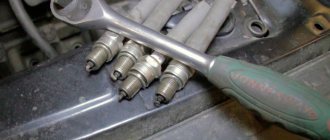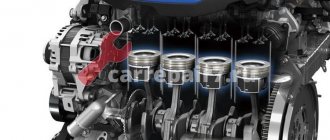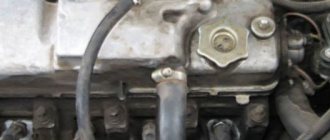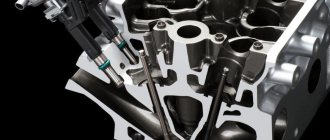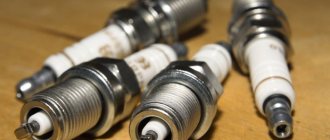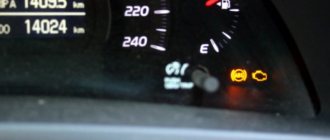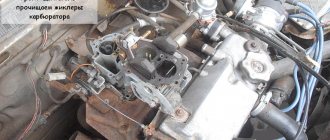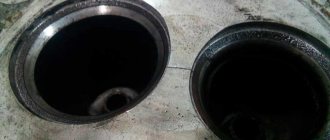How can you tell if the engine is leaking?
Signs that the VAZ 2114 engine is malfunctioning:
- jerks when driving or accelerating a car - the car does not develop the necessary power;
- increase in fuel consumption - due to malfunction of the injection system;
- uneven exhaust - you can hear popping noises and smell unburnt gasoline;
- vibrating, uneven sound of the engine - due to malfunction of the valves and all rotating parts of the engine;
- feeling of vibration and “shaking” at idle.
The origin of the phrase dates back to the days of four-cylinder engines. If one of the cylinders failed, three remained operational. Now the engine design has changed, but the common expression remains.
Main reasons
The following reasons can lead to such a breakdown:
- low level of compression in the cylinders (for example, due to poor valve fit);
- injector contamination - the injection system is disrupted as a result of poor flow or fuel overflow;
- lack of spark supply to the spark plug - due to a malfunction of the spark plug or high-voltage wire;
- air filter contamination;
- control unit failure;
- malfunction of the crankshaft position sensor;
- change in position, or initial incorrect installation of the timing belt.
Failure of one cylinder can lead to breakdown of the entire engine. The gasoline that enters the idle cylinder does not burn out and mixes with the oil. As a result, the oil loses its properties and engine parts begin to wear out.
Possible reasons
It turns out that there are quite a lot of reasons for such a malfunction in the VAZ-2114 engine. They directly depend on the nature of the vehicle malfunction. So, most often the VAZ-2114 engine will triple due to:
- non-working candle;
- broken high-voltage wire;
- ignition coil failure;
- faulty control unit;
- presence of air leaks in the intake manifold;
- exhaust valve burnout;
- broken cylinder head gasket;
- broken compression rings on the piston;
- burning out of the piston itself;
- a broken piston bridge between the compression rings.
How to find out the exact cause of the breakdown?
To determine why the VAZ 2114 engine is tripping, you need to:
If you have an ODBII scanner, first of all you should carry out a comprehensive diagnosis using it. In our case, we will use a Korean-made scanner Scan Tool Pro Black Edition
.
This device was developed for the CIS market and is compatible with most domestic cars, as well as foreign cars produced in 1993. Connects via wi-fi or bluetooth and displays information on any device in Russian.
If the problem is in the cylinders, Scan Tool Pro
will show one/several errors: P0300, P0301-P0304 (PO301 code corresponds to a malfunction in the 1st cylinder, PO302 in the 2nd, etc., respectively). Also, using this device, you can track the operation of all available sensors in real time, the actual mileage of the car, its VIN and much more.
If you don’t have a scanner, use the following method:
- Detect a dead cylinder:
- start the engine and gain access to it by lifting the hood;
- remember the sound of a running engine;
- remove the wires from each cylinder one by one;
- If the sound of the working cylinder changes when you remove the wire, it means it is working. In the event of a malfunction, the character and rhythm of the sound does not change even after the power is turned off.
- Find out if a spark is getting to the cylinder:
- remove the spark plug using a special key;
- clean it from carbon deposits and soot. Sometimes simple cleaning helps, but this is only a temporary measure;
- check the integrity of the electrode. High voltage wires can be checked using a conventional multimeter;
- check for spark supply to the spark plug. To do this, you need an assistant to start the starter. The spark plug with the high-voltage wire must be attached with the metal part to the engine. If a spark does not appear when the starter bendix rotates, then the spark plug is faulty.
Poor quality fuel - sand or rust in gasoline can cause contamination of the injectors. Engines with injection type are very demanding on the quality of gasoline. Therefore, if there are problems with the engine, it is recommended to drain the fuel and use another one.
The engine stalls when cold
There are situations when the engine only stalls at idle speed. If a VAZ 2114 stalls when cold, most often the reason is a large gap between the valve and its rocker (“rocker arm”). After the engine warms up, the distance decreases and the cylinder operation stabilizes.
Other reasons are also possible:
- A “rich” or “enriched” fuel mixture is supplied due to a malfunction of the control unit.
- There is moisture on the wires or ignition coil.
- The spark plug does not work until the engine warms up.
- The piston group is worn out.
- The valve is deformed due to water hammer.
Troubling when the engine is warm
If problems with operation are observed only when the engine is warm, then the probable causes are:
- Damage to the engine control unit.
- The ignition coil sparks (pierces).
- The cylinder head gasket is worn.
Engine control unit for VAZ 2114
Causes of poor-quality stove operation
Based on the complex structure of the stove, it becomes clear that it may not work correctly for many reasons. A malfunction of at least one of the components and components of the heating system can lead to a malfunction of the stove. In this case, a malfunction may occur due to the driver’s fault, or it may be a consequence of aging or incorrect operation of other vehicle systems.
Problems with the stove can manifest themselves in the following ways:
- Poor interior heating.
- Cold air from the stove.
- Variable temperature of air supplied from the stove.
- Weak flow of hot air from the stove.
- The heater in the car does not turn on.
Knowledge of the structure of the stove itself and possible breakdowns will make it possible to avoid large expenses when repairing a car. Let's look at the most common causes of poor-quality stove operation below.
Fan doesn't work
A fan malfunction can often be one of the problems with heating the interior. The cause of this failure is usually damage to the bearings or graphite brushes, which may require complete fan replacement. Also, the fan may be faulty due to the blown fuse or relay in the electrical power circuit, which is also a reason to contact a car service center.
If the fan makes a whistle during operation, and its rotation speed changes from minimum to maximum and vice versa, then the cause of the problem may be a failure of the fan motor. In such conditions, the radiator may remain hot, but it will not be possible to warm the interior to the desired degree.
Insufficient coolant level
A malfunction of the stove can be caused by a coolant leak, as a result of which heat stops flowing into the cabin radiator in the required volume. This in turn leads to a decrease in the volume of antifreeze in the expansion tank. To fix the problem, you need to find the location of the leak, add antifreeze to the expansion tank, and sometimes it may be necessary to replace the coolant supply valve.
Engine pump faulty
The pump is used to circulate antifreeze and to ensure proper functioning of the stove. If such a pump breaks down, a malfunction may occur in many engine components, including the vehicle interior heating device.
A malfunction of this part can be caused by wear on the inside of the impeller, a broken crankshaft belt, or even jamming of the pump itself. It is better to eliminate this kind of problem by completely replacing the pump, and to avoid such breakdowns, it is recommended to regularly check the hose leading to the pump, and also listen to sounds under the hood.
Blown engine head gasket
The head gasket is designed to connect the block and the car engine head itself, ensuring tightness and preventing coolant and fuel from mixing with each other. Burnout of the gasket in the engine cooling jacket leads to the generation of exhaust gases, which can enter the cooling system through the pipes. In this case, the heat exchanger becomes airy and the efficiency of its operation decreases, the coolant can heat up, and malfunctions are observed in the operation of the stove.
Thermostat malfunction
The thermostat is a device directly involved in the circulation of coolant, so its malfunction will affect the air temperature in the cabin. Since the thermostat can be in an open or closed position, its failure is characterized by jamming in one of these positions.
If the thermostat is stuck in the closed position while driving in city traffic, the temperature of the antifreeze may increase, and subsequently the engine may overheat. When stuck open, the interior temperature will be low when driving in high gears, while the temperature will remain normal at low speeds.
Heater core blockage
The heater radiator can become clogged for various reasons, and this can happen both from the outside and from the inside. For example, the outside of the radiator may become clogged due to dust, leaves, and insects entering through the protective casing. On the inside, clogging occurs due to dirt and deposits that can form in the engine cooling system.
Cabin filter clogged
A heavily contaminated cabin filter is one of the common causes of stove malfunctions. Many drivers treat it quite dismissively and do not replace or throw away the old one for a long time.
It should be remembered that a clogged filter is an obstacle to the flow of heated air into the cabin. In addition, when the filter is clogged, dust and mold spores can enter the cabin and accumulate in the filter itself.
How to fix the problem?
After the reasons why the VAZ 2114 engine is tripping have been determined , it is necessary to act depending on the situation:
- If there are problems in the ignition system, replace the broken spark plug or high-voltage wires.
- If the reason is in the fuel injection system or compression level, clean the injectors with ultrasound, adjust or replace the valves, air filter, check the position of the timing belt.
If these actions do not lead to results, you need to check and, if necessary, replace:
- Control block;
- crankshaft position sensor;
- oxygen sensor.
Thus, engine tripping is a common breakdown that, with experience and skillful hands, can be corrected on your own. If the cause of the tripping is a breakdown in key systems (control units) or there is no special equipment at home (for example, for cleaning injectors with ultrasound), it is recommended to contact a service station.
How to determine a bad cylinder
Having noticed that the check is flashing, the VAZ 2114 engine begins to trip, the first thing you need to do is determine the non-working cylinder.
To do this, the following steps are taken:
- start the engine and open the hood;
- listen to and remember the nature of the engine operation;
- We remove the high-voltage wires from the spark plugs one by one. As soon as the sound does not change when the wire is removed, it means that the bad cylinder has been identified.
The next step is to unscrew the spark plugs and determine their condition. Soot on spark plugs is an important indicator of adequate operation of the power unit. Assessing the condition of the spark plug will help determine why the engine in a VAZ 2114 is stalling.
| Insulator color | Possible reason | Associated symptom | ||
| Light brown or coffee. | The spark plug works under normal conditions. | — | ||
| Matte black soot. | Increased fuel consumption. | Failure of the injection mechanism sensors, poor compression, broken ignition timing, problems with the enrichment. | ||
| Light grey, white. | Lean air-fuel mixture. | Using a spark plug with a low potassium number, a malfunction in the cooling system, using low-quality fuel, air leaks, clogged injector. | ||
| Reddish, brick tint | Caused by the operation of the unit on gasoline with additives that increase the octane rating. | Constant use of such fuel will lead to the appearance of deposits on the electrode insulator, and the spark plug will begin to pierce. | ||
| Black oily soot | Decreased power performance, tripping, increased oil and gasoline consumption. | Cold spark plug, oil entering the combustion chamber from the crankcase due to wear or damage to the oil scraper rings and valve guides. | ||
| Destruction of the central electrode and ceramic skirt | The cylinder is faulty and the engine is constantly shaking. | Prolonged engine operation with detonation, use of low octane gasoline, defective spark plug. | ||
| Erosion of electrodes. | Poor start, VAZ 2114 troits, does not develop the required power | Failure to comply with the period for replacing spark plugs (replacement is carried out after 25 thousand km), use of gasoline with an increased amount of tetraethyl lead. | ||
Useful video
For more information, watch the video below:
Hello. Such a problem. Auto VAZ 2114 1.5. It all started with the fact that the dynamics were lost and the car did not always start the first time. It started to choke, the revolutions fluctuated from 100 to 1000 and eventually stalled. The second time it started perfectly. From attempts to restore dynamics: 1) Changed the air filter 2) cleaned the throttle valve 3) cleaned out a bunch of deposits from the crankcase ventilation pipe, 4) checked the spark plugs (everything is fine with them, but cleaned them just in case) 5) replaced the fuel pump mesh Changes if and were then insignificant. It seemed that there was an air leak between the air filter and the air flow sensor (I could tell by sound and felt it with my fingers). This morning I went for a new seal, bought this ill-fated rubber ring and went to install it. I did everything as it should, but decided that in the place where the air flow sensor enters the box with the air filter there is still a lot of non-rubberized space (which the seal does not reach). I quickly cut out a rubber ring from the old gasket, put it on the air filter, put a new gasket on top and I pushed the filter in, it went in with force, but I was absolutely sure that nothing else would be allowed through. I started it, everything was fine, but as I drove I realized that it was not normal. When I sharply pressed the gas pedal, dips appeared, the car began to twitch and did not immediately gain momentum. I drove about 10 kilometers like this and decided that I needed to remove that extra rubber ring, although I had little faith that it was because of it that it all started. removed it, nothing changed.
Now I checked the MAF by disconnecting the wire on the sensor. rpm at idle became 1200-1300. When driving, there are also dips when you sharply press the gas pedal. It turns out that it’s not his fault.
I blame the ignition module or the wires. Tomorrow I plan to check the high voltage wires with a multimeter. Are there any other options that should be checked first?
By the way, when I changed the mesh on the fuel pump, the pump itself fit very loosely into the glass. Could it be that on a bump it will fall off in my gas tank, and what are the consequences? is it worth checking?
And one more question (forget about the dips when you sharply press the gas, this question was relevant to me earlier). In first gear I hit the floor, at 4000 the car stops actively accelerating (as if you let go of the gas pedal, you’re pushing your chest against the belt a little), in second gear it’s also about 4-4.5. The arrow after this mark rises reluctantly, and I try not to torture it and switch. Does this clutch spin? Or could there be something else the problem?
If interruptions regularly occur during the operation of the car engine, and the sound emanating from the exhaust pipe is more like the growl of a tractor, this indicates that your engine is having problems. This problem needs to be solved, and quickly.
The main reasons for tripling
If you say that your engine is not working, many will answer that the cylinder is not working. But this argument is not entirely correct, since the cylinder stops working properly. However, there may be several reasons for this:
- Compression in cylinders is too low;
- The spark plug is faulty or partially does not perform its functions;
- The valves do not fit well due to a long lack of adjustment;
- The injectors are dirty or overfilled and therefore need to be replaced;
- The oxygen sensor has stopped functioning;
- The high-voltage spark plug wire has been damaged;
- The ignition coil is faulty;
- DPKV (crankshaft position sensor) does not work;
- The ECU (electronic control unit) is broken;
- The timing belt has fallen off or simply slipped a few links;
- The air filter is faulty or dirty.
Primary signs of a problem that may indicate a cylinder failure are:
- Vibration increases because the rhythm of the valves and other rotating parts of the gearbox and power unit is disrupted.
- Fuel consumption increases noticeably because the injection system no longer works properly.
- An unpleasant characteristic odor is heard from the exhaust pipe, which is explained by the high level of concentration of harmful impurities and unburned fuel.
- The power of the power unit drops noticeably, which negatively affects the dynamics and maneuverability of the car.
If you notice that the engine is shaking, but have not taken any measures, this will soon threaten you with complete failure of the engine, which may be impossible to repair. When the injection 8-valve engine on a VAZ 2114 is running, fuel constantly flows into the non-working cylinder. It does not burn, but mixes with oil and then goes into the crankcase. If the process continues for a long time, the oil loses its viscosity, ceases to act as a lubricant, parts work under extreme loads, and the metal turns into chips. There is nothing good about this, let's be honest.
What to do?
There are a number of measures that are recommended to be taken when it is discovered that the engine is tripping. All of them will allow you to answer certain questions. Therefore, get ready to devote a lot of time to your car.
The first thing you need to do is identify the failed cylinder. He's not alone there.
To do this you need:
- Open the hood while starting the engine;
- Listen and remember the sound your engine is making now;
- Remove the wires from the spark plugs one by one. If you remove the high voltage wire, the sound should change. If, when removing the next high-voltage cylinder, the sound does not change, congratulations, you have found the faulty cylinder.
Now we dismantle the problematic spark plug and check it for functionality.
To do this, you will need a special wrench designed specifically for removing spark plugs:
- Pay attention to the electrode. If it is clean and intact, but there is a lot of burning on the head, most likely there is a large amount of dust in the combustion chamber. This indicates a malfunction of the air filter in the air supply system;
- If soot is present on the head and the electrode, which is noticeably burnt out, the mixture is poor, combustion occurs with premature ignition;
- If the head is burnt, but the electrode is intact, the mixture was rich and the ignition was delayed;
- Check for spark. If it is, then the problem needs to be looked for further. When there is no spark, it is recommended to replace it with a new one and check the performance of the engine with a new spark plug.
If your car has quite an impressive mileage, it is recommended to perform the following operations to identify the causes of the “triple”:
- Replace spark plugs;
- Dismantle the old high-fibers and replace them with new, high-quality ones. Sometimes banal microcracks on them lead to breakdowns and failure of the entire power unit;
- Measure the compression in the cylinder that is not firing. When detecting violations, you may determine that the valves are burnt out or the problem is in the rings;
- Perform valve adjustments. In general, a similar procedure is carried out at intervals of 15-20 thousand kilometers for the purpose of prevention;
- Check if the ignition coil is working. A common problem for the VAZ 2114. There is no point in trying to repair it; it is better to immediately replace it with a new one. It won't cost you a fortune;
- Replace the old air filter with a new similar unit;
- Check that the timing belt is installed and functioning correctly.
Even if these measures did not produce any results, we advise you to try a few more effective methods for restoring engine performance:
- Check the operation of the electronic control unit. If problems are detected, immediately replace the old electronic control unit with a new one;
- Check the functionality of the fuel supply system. In some cases you will have to get all the way to the injectors;
- Analyze the operation of the oxygen sensor. It can be repaired, but it would be better to replace the device immediately;
- Make sure the crankshaft position sensor is working properly. This is determined using an electronic control unit. It will display an error indicating that there is a problem. If there are problems with the sensor, there is nothing else to do but replace it with a new one.
What to do if it crashes at idle
This is also a fairly common situation, with a total of three causes.
- There were problems with the fuel supply. It is necessary to flush the fuel system and clean the injectors with ultrasound.
- There is a malfunction in the ignition system. In such a situation, it is recommended to change the spark plugs, check the functionality of the ignition coil, and install a new set of high-voltage wires.
- Valves are not adjusted properly. You will need to adjust the valves. If the situation requires more drastic measures, then the valves will have to be changed.
If you intervene in the operation of the unit at the first sign of “triple”, you will be able to avoid complex and expensive repairs. But when the situation takes its course and checking the unit is postponed day after day until later, get ready to soon spend a lot of money or even look for a new engine to replace the old one.
Why does the VAZ-2114 engine suffer from injector problems?
It often happens that the VAZ-2114 engine malfunctions. One of them is what motorists call “engine trouble.” What does this concept mean? What are the signs of such a malfunction in the engine and what are the reasons for the tripping? Is it possible to fix this problem?
How to understand what is wrong with the VAZ-2114 engine
The concept of “engine tripling” was invented by motorists themselves. It is associated with the design and operation of four-cylinder internal combustion engines. If one of the four cylinders failed, the internal combustion engine still continued to operate on the three remaining cylinders. But such a failure was distinguished by a characteristic sound, which was called “engine tripping” - functioning on only three cylinders. In this case, the fuel mixture in the idle cylinder will not burn as expected, but will accumulate.
If you do not respond to such a failure in the system in time, the fuel mixture will be diluted with oil, enter the crankcase with oil and dilute it thinner and thinner. In this case, the oil will lose its lubricating functions, which will lead to rapid wear of the rings, cylinder-piston group and other important parts of the car. A little later, the engine will have to be repaired not partially, but completely.
Similar failures occur in the VAZ-2114. They can be recognized by their characteristic features:
- The engine in idle mode manifests itself with periodic twitching, unevenly.
- When driving, the VAZ-2114 does not gain the required power.
- The car moves jerkily.
- If you press the gas pedal, failures in engine operation will be detected.
- An uneven exhaust comes out of the muffler, which is interrupted and accompanied by popping noises.
Against the background of these signs that the VAZ-2114 engine is failing, the driver may notice an increase in fuel consumption.
Possible reasons
It turns out that there are quite a lot of reasons for such a malfunction in the VAZ-2114 engine. They directly depend on the nature of the vehicle malfunction. So, most often the VAZ-2114 engine will triple due to:
- non-working candle;
- broken high-voltage wire;
- ignition coil failure;
- faulty control unit;
- presence of air leaks in the intake manifold;
- exhaust valve burnout;
- broken cylinder head gasket;
- broken compression rings on the piston;
- burning out of the piston itself;
- a broken piston bridge between the compression rings.
But since we are considering a VAZ-2114, the engine can also be damaged by faults in the injector - a fuel system with distributed injection.
What to do if the engine on a VAZ-2114 is malfunctioning
To understand the causes of malfunctions in the VAZ-2114 engine, you need to know its configuration. He has:
- there are eight valves in the cylinder head;
- 1.6 liter internal combustion engine with 16 valves.
Experts advise that at the first signs of tripping, immediately check the functioning of the spark plugs. To do this, carry out the following steps:
- One by one, pull off the high-voltage wires from the cylinders.
- Pay attention to changes in engine operation:
- if there are no changes, the cylinder does not work.
The next step is to check the spark in the ignition system. This procedure is also simple:
- The first step is to remove the tip from the high-voltage wire.
- While the car engine is running, bring the wire from the cylinder head (ground) to the “break” position.
- Check for a spark between ground and wire:
- If there is no spark or the spark is too weak, then the ignition system is faulty.
But the following situation also happens: the spark is powerful, but malfunctions are still heard in the engine. This means that the time has come for the next step of testing - to measure compression in the cylinders, preferably in all of them at once. If the cylinder is operating correctly, there should be no difference in the pressure gauge readings (minor deviations are allowed). If the cylinder is faulty, there will be no or very weak compression.
A malfunction in the cylinder may be due to one of the following reasons:
- cylinder head gasket is broken;
- exhaust valve burnt out;
- piston rings burst;
- The piston itself burned out.
If you are unable to independently identify the reason that the VAZ-2114 engine is malfunctioning, you definitely need to do computer diagnostics.
This can be done in two ways:
- On a special computer stand.
- Using a portable scanner (for example, ASKAN).
An experienced motorist himself will be able to figure out the malfunctions of the VAZ-2114 engine, but if he does not have sufficient experience, then it is best to contact qualified specialists at a service center for servicing cars of this model.
Checking the engine at idle
If you notice that the VAZ-2114 engine starts to stall at idle, then you need to check the following systems:
- Fuel supply system.
- Ignition system.
- Valve system.
In the first case, if the faults are in the fuel supply system, then the first step is to flush the fuel system, and then clean the injectors using ultrasound.
The second case involves problems with the ignition system. Therefore, perform the following actions:
- change spark plugs;
- check the functionality of the ignition coil;
- update the set of high-voltage wires.
In the third case, the valves are closely dealt with, that is, they should be adjusted so that they perform their functions properly. If this cannot be done, the old valves are simply replaced with new ones.
How to restore the performance of a VAZ-2114 engine: expert advice
Automotive repair experts recommend that motorists use several tips to restore the functioning of a VAZ-2114 engine that is tripping.
- First tip: check and replace the electronic control unit.
- Second tip: check and replace the oxygen sensor.
- Third tip: check the functionality of the crankshaft position sensor. This can be done using the electronic control unit. This device will generate an error if the crankshaft position sensor is faulty. This means you will have to replace it with a new one.
- Fourth tip: check and replace the ignition coil.
- Fifth tip: check and replace the air filter.
- Sixth tip: check the correct placement of the timing belt.
As you can see, almost every piece of advice contains two stages - checking and replacing some part related to the proper functioning of the VAZ-2114 engine. Therefore, the easiest way would be to immediately allocate a few hours of your time in order to come to grips with the search for the problem of its tripling. Although the best option, but more expensive, is to entrust the inspection to qualified service center specialists, who will find a solution to the existing problem much faster.
Unstable operation in cold conditions
From time to time, drivers encounter a problem: the VAZ 2114 engine stalls during a cold start, but as it warms up, the operation evens out. In this case, the reasons may be:
- large valve clearance;
- low compression, wear of compression rings;
- the mass air flow sensor is faulty;
- air leakage under the intake manifold gasket;
- poor quality fuel;
When the car shows signs of shaking, you should contact a service center for diagnostics. Diagnostics are carried out using special equipment, where a specialist can accurately determine the cause of the malfunction. Of course, if you have enough experience, you can figure out the reasons for the unstable operation of the engine yourself.
It often happens that the VAZ-2114 engine malfunctions. One of them is what motorists call “engine trouble.” What does this concept mean? What are the signs of such a malfunction in the engine and what are the reasons for the tripping? Is it possible to fix this problem?
Signs of the reason why the engine is tripping
Engine trouble: what is it, and what are the signs to identify this malfunction? You can understand that the internal combustion engine is malfunctioning by the following signs:
- At idle speed, the engine operates unevenly, jerking periodically;
- The car does not develop the required power when driving;
- The car drives jerkily, when you press the gas pedal, there are gaps in operation;
- The exhaust from the muffler is uneven, with interruptions, pops and shots are possible;
- Fuel consumption increases.
Causes:
There are many reasons why an engine misfires. There are such nuances that even experienced technicians do not immediately determine the nature of the malfunction.
But the most common cylinder failures are the following (starting with the elementary ones):
- The candle does not work;
- The high-voltage wire is broken;
- The ignition coil has failed;
- The control unit is faulty;
- There is an air leak in the intake manifold;
- Exhaust valve burnt out;
- The cylinder head gasket is broken;
- The compression rings on the piston are broken,
- The piston itself has burned out, or the bridge on the piston between the compression rings has burst.
This article is about the VAZ 2114 car, so carburetor malfunctions are not considered, since this device was not installed on the 2114 model. This brand of car has a fuel system with distributed injection (injector), and the answer to the question of why the engine stalls may be hidden in this system.
Causes of interruptions on a warm engine
There are times when a cold engine works normally, but as it warms up it starts to stall. This happens due to a mismatch in valve clearances: on a cold unit the clearance is normal, but when it warms up, the valves begin to tighten; It is also worth checking the integrity of the head gasket, electronic control module and ignition coils, which may break due to damaged wiring.
Characteristics of the VAZ 2114 engine
The VAZ 2114 car is mainly equipped with an 8-valve 4-cylinder engine, the fuel system and ignition are controlled by an electronic unit (ECU). The electronics have many different sensors that inform the unit about the condition of the engine.
The control unit, in turn, reads the necessary information and gives commands to those devices that directly affect the operation:
- Distributes the spark among the cylinders in a certain order;
- Determines the required amount of supplied fuel (leans or enriches the fuel mixture depending on the number of revolutions).
The electronic control system of the VAZ 2114 contains the following sensors:
- Crankshaft position sensor (CPS);
- Camshaft position sensor or phase sensor (DPRV);
- Idle air regulator (or sensor) (IAC);
- Throttle position sensor (TPS);
- Knock sensor (DS);
- Air flow sensor or flow meter (AFM);
- Lambda probe or oxygen sensor.
Failure of any of these sensors leads to unstable engine operation, and if the DPKV fails, the car most likely will not start at all. Fuel is supplied to each cylinder using an electronically controlled injector. A faulty injector can also cause poor engine performance.
Reasons for unstable operation of the VAZ 2114 engine
Let's consider several standard situations that can happen with an 8-valve 4-cylinder engine.
Doesn't work well when cold
It often happens that a VAZ 2114 stalls when cold, but as it warms up the engine levels out and starts working stably.
There could be several reasons:
- The ECU sets the fuel mixture too rich to cold;
- The spark plug does not work, but when heated, the spark plug still “breaks through”;
- The high-voltage wires are damp or moisture has entered the ignition coil;
- Parts of the piston group are worn out.
Doesn't work well when hot
It also happens the other way around - a cold internal combustion engine operates more or less steadily, but as it warms up it begins to throttle.
Usually the engine starts when hot because:
- The cylinder head gasket has burned out;
- The ignition coil breaks;
- The engine control unit is faulty.
Engine control unit for VAZ 2114
Troits at idle
Most often, a situation arises when the engine stalls at idle speed. Moreover, it makes no difference whether this happens when it’s cold or when it’s hot. There can be many reasons for this, ranging from a simple spark plug failure to malfunctions in the piston group of the internal combustion engine. While it is very easy to replace a spark plug, wear on the cylinders in the block can lead to a major overhaul.
Most often, the engine does not operate stably at idle in the following cases:
- The valves are not adjusted (clamped);
- The timing belt is installed incorrectly (the marks do not match);
- The IAC is faulty;
- The cylinder head valves are bent or burnt out (the valves can bend during a water hammer when a large amount of water gets into the air filter housing);
- The piston burned out;
- There is a malfunction in the electronic engine control system. The sensors, the ECU itself, electrical wiring and I/O wires may be to blame here.
There are many options for why the car idles at idle, but there are still the most basic ways to determine faults.
Troit in wet weather
Yes, and this is not a joke. Many owners who have VAZ cars note that recently washed or just on a damp day, “iron horses” begin to trip.
Common causes include fluid that has gotten into the spark plug wells.
As a result, the spark plug stops sparking, which means the cylinder cannot work correctly. But that's not all.
Thus, various sensors could fail due to exposure to an aggressive environment. Also, when washing with high pressure washers, various vulnerable parts could be damaged.
As for environmental conditions, in wet weather the engine stalls after a long period of inactivity. The engine does not start immediately, but after the fifth or sixth time. The engine runs rough and unstable until it warms up completely. Visual inspection often does not give results. Engine operation becomes normal after some time until it cools down completely or until the next rain. The reason here is partly the same as after a car wash.
Dampness, or more precisely, condensation accumulates under the distributor body. There is an easy way to diagnose this problem. Start the engine in the dark. If you see lights under your hood, you need to replace the wires.
Don't forget about candles. If the engine does not want to start in damp conditions, then most likely the spark plugs need to be replaced. They may have stopped producing a strong spark. On a wet, rainy day, moisture can accumulate on the candles, which leads to current leakage. Ignition coils are also often to blame. Their bodies crack, and condensation accumulates in them.
What to do if the engine fails
The car model 2114 from the factory was mainly equipped with an engine with 8 valves in the cylinder head; a 16-valve internal combustion engine (1.6 l) was installed in 2010. VAZ 2115 (also 2113) has an identical engine, so we will consider the method of finding the cause of the malfunction for all these models.
We will learn in detail about what to do when a VAZ engine stalls when cold or hot, at idle speed or when the load increases. If the engine of a VAZ 2115 (2114, 2113) fails, first of all we check the operation of the spark plugs. Alternately pulling off the I/O wires from the cylinders, we pay attention to how the operation of the internal combustion engine changes. If the nature of the operation does not change when the wire is removed, then it is this cylinder that is faulty.
It may also be due to the lack of a spark in the ignition system. Checking the spark is very simple. The tip is removed from the high-voltage wire, and with the engine running, the wire is brought to the ground of the car (to the cylinder head). That is, it is placed on a “break”. A fairly powerful spark should jump between the wire and ground. A weak spark or its absence indicates a malfunction in the ignition system.
If the spark is good, but the VAZ 2114 engine still misfires, then you should check the compression in the cylinders, preferably in all of them at once. When measuring compression there should be almost no difference in the pressure gauge readings. Weak compression or its absence indicates a malfunction inside the cylinder itself.
- The cylinder head gasket is broken;
- Burn out the exhaust valve;
- The piston rings may burst or the piston will burn out.
Vehicle malfunction at idle
If the VAZ 2114 power unit idles at idle, then:
In the first case, the fuel system is flushed and the injectors are cleaned. To carry out the last work, ultrasound is used. In the second case, you will need to replace the spark plugs, high-voltage wires, and diagnose the ignition coils. In the latter case, the valves are replaced or readjusted.
If the power unit stalls while running hot, then auto mechanics advise carrying out similar work as described above. At idle speed with a heated engine, one cylinder may not work due to malfunctions in the fuel mixture supply system or lack of spark. In this case, it is recommended to carry out the same work as in case of failures during cold running.
Before you begin independent repair work, you need to find out what tripling of the power unit is. This concept means the operation of the engine without the participation of one of the cylinders. If such a process is accompanied by a blinking check, then the lambda probe, fuel tank filler cap, catalyst, air mass flow sensor are checked. The motor indicator icon appears without warning, so it is impossible to immediately find out the reason for the blinking check. Before repairing a VAZ, the electrical circuit and design features of the vehicle are studied.
If you lack experience and knowledge in the field of electromechanics, it is recommended to seek help from a specialized service.
